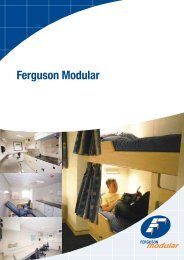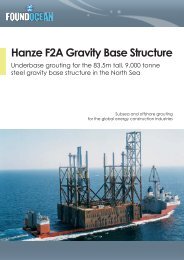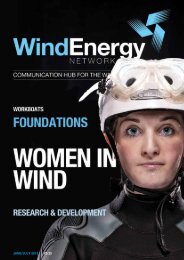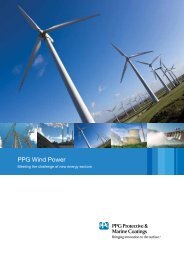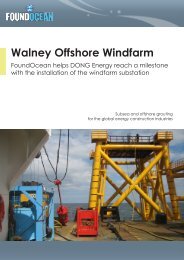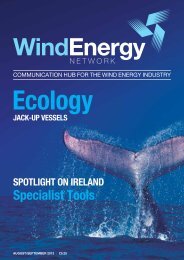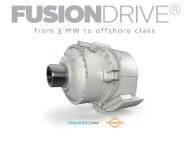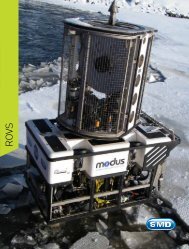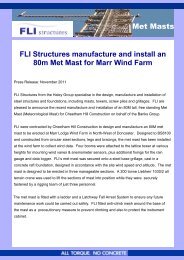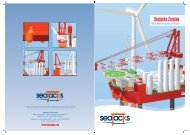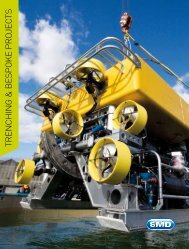WORKING AT HEIGHTS - Wind Energy Network
WORKING AT HEIGHTS - Wind Energy Network
WORKING AT HEIGHTS - Wind Energy Network
Create successful ePaper yourself
Turn your PDF publications into a flip-book with our unique Google optimized e-Paper software.
SPONSORS OF TYNE & TEES FE<strong>AT</strong>URESouth TynesideCollegeSouth Tyneside College’s MarineSafety Training Centre is one ofthe foremost training facilities inthe UK and has been developed toprovide the most realistic trainingenvironment possible.Within their training pool area there is aneight-seater helicopter escape module,helicopter winching arrangements, davitlaunchedlife raft equipment, a rangeof marine and aviation life rafts, survivalsuits, life jackets and associated survivalequipment, and an offshore platformtransfer simulator. The centre also has ajetty which provides mooring.A large, practical seamanship area isequipped with a wide range of shipboardequipment and models of ships’ structuresand devices. Other accommodationincludes modern classrooms and meetingrooms.urgent need for a review ofstandardsGraham Johnson is Head of School atSouth Tyneside College’s Marine SafetyTraining Centre in South Shields. He isa professional mariner to rank of Masterand has worked around the UK’s coastin tankers, supply boats and anchorhandlers. He also spent two years onsemi-submersible rigs in the North Seaand ran fishery patrol and survey vesselsfor the Environment Agency. He joined thecollege 13 years ago.Graham explains...To ensure the safety of employees, Ibelieve a review of the training standardis urgently needed within the marinesafety industry for transfer from vessel toinstallation.More realistic but controlled and safetraining is required than is currently laiddown by Renewable UK (RUK) and theEurope-wide Global <strong>Wind</strong> Organisation(GWO), the two safety accreditationbodies.Industry questionsTo start that process, two questionsshould be pondered by our industry andits regulators as they seek to give theiremployees the best possible training andfulfil their duty of care.1 Is transfer training in what can bedescribed as ‘benign’ conditions doinganyone any favours?2 How many days a year are the windand sea conditions around Europe’sshores so good that a transfer to orfrom an offshore turbine can be calledbenign?ExperiencesI have experienced a transfer in nearperfect conditions on Burbo Bank but,with the ever present risk of bow wavesfrom passing ferries and other vessels,nothing should be taken for granted.In the early days of RUK, a large numberwithin a sea survival working party arguedagainst transfer training in unrealisticconditions, those conditions which fail tomatch how it really is in the water.It was noticeable that those most in favourof this were those who were unable tocontrol the sea or water conditions andwho would have been at a disadvantageif the standard had dictated a set waveheight transfer requirement.Having delivered transfer training to amajor European company which specifiedtransfer in wave conditions, and havinggiven all our delegates the option ofbenign or wave conditions, all requestedmotion. I have no doubt that this is thebetter option.ObservationsVideo footage from inside transfer vesselsor from fixed cameras on installationsshow that transfers are taking placeroutinely in large wave conditions andthat individuals are transferring withoutadequate training. Comments fromdelegates on boat transfer courses reenforcethis point.Training providers across the country offerheight training. This intensive instructiontakes place at a realistic height and overtwo days offering training for a task that isin the main predictable and controlled.UnpredictableHowever, the transfer to or from a ladderto a vessel around the shores and furtherout to sea in European waters is far fromroutine and is unpredictable.Sadly, RUK and GWO require us only todo training that is carried out in the flatcalm and for only a very short period oftime, with no emergency scenarios orrescues practiced.No mandatory guidelinesFortunately, neither organisations’guidelines are mandatory and at therequest of individual companies wecarry out training as realistic as possibleto those witnessed around Europe’scoasts in our 4m-deep, 18m by 10menvironmental pool by using our variablewave pattern generator, as well as wind,rain, light and sound effects.Urgent needIt is because of RUK and GWO’sunrealistic guidelines that a review of thetraining standard is urgently needed. Thisis an industry that is growing rapidly, isin the public eye and can attract adversepublicity - and has no excuse from notlearning from industries that have workedwith the sea for decades.Graham JohnsonSouth Tyneside Collegewww.stc.ac.ukwww.windenergynetwork.co.uk 57



